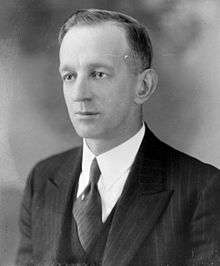1943 Ontario general election
The 1943 Ontario general election was held on August 4, 1943, to elect the 90 Members of the 21st Legislative Assembly of Ontario (Members of Provincial Parliament, or "MPPs") of the Province of Ontario, Canada.
| |||||||||||||||||||||||||||||||||||||||||
90 seats in the 21st Legislative Assembly of Ontario 46 seats were needed for a majority | |||||||||||||||||||||||||||||||||||||||||
|---|---|---|---|---|---|---|---|---|---|---|---|---|---|---|---|---|---|---|---|---|---|---|---|---|---|---|---|---|---|---|---|---|---|---|---|---|---|---|---|---|---|
| |||||||||||||||||||||||||||||||||||||||||
| |||||||||||||||||||||||||||||||||||||||||
The Ontario Progressive Conservative Party, led by George Drew, defeated the Ontario Liberal Party government. The Liberal government had disintegrated over the previous two years because of a conflict between Mitchell Hepburn, the Ontario caucus and the federal Liberal Party of Canada.
Hepburn resigned and was eventually succeeded by Harry Nixon in early 1943. The change in leadership was not enough to save the government. The election held later that year resulted in the Conservative Party, recently renamed the "Progressive Conservative Party", winning a minority government. This began forty-two uninterrupted years of government by the Tories who combined moderate progressive policies with pragmatism and caution.
The Liberals fell to third place behind a new force, the socialist Ontario Co-operative Commonwealth Federation (CCF), led by Ted Jolliffe, went from obscurity to form the Official Opposition, winning 32% of the vote and 34 seats in the legislature, just four short of Drew's Tories. The Liberals and their Liberal-Progressive allies fell from 66 seats to a mere 15.
Two members of the banned Communist Party of Ontario running as "Labour" candidates won seats in the Legislature for the first time in this election: A.A. MacLeod in the Toronto riding of Bellwoods, and J.B. Salsberg in the Toronto riding of St. Andrews. Several days following the election the Labor-Progressive Party was officially formed and Salsberg and MacLeod agreed to sit in the legislature as the party's representatives.
Results
| Party | Leader | 1937 | Elected | % change | Popular vote | ||
|---|---|---|---|---|---|---|---|
| % | change | ||||||
| Progressive Conservative1 | George Drew | 23 | 38 | +65.2% | 35.7% | -4.3% | |
| Co-operative Commonwealth | Ted Jolliffe | 0 | 34 | 31.7% | +26.1% | ||
| Liberal2 | Harry Nixon | 63 | 15 | -76.2% | 31.2% | -20.4% | |
| Labor–Progressive2 | - | 2 | |||||
| Liberal Independent | 1 | 1 | - | ||||
| United Farmers3 | 1 | * | - | ||||
| Liberal–Progressive4 | 2 | * | - | ||||
| Total | 90 | 90 | - | 100% | |||
Note:
1 The Conservative Party renamed itself the "Progressive Conservative Party" in 1943.
2Salsberg and MacLeod, members of the banned Communist Party, ran and were elected as "Labour" candidates. The Labor-Progressive Party was formally founded several days after the election and Salsberg and Macleod agreed to sit in the legislature as LPP representatives.
3In 1940, United Farmers of Ontario MLA Farquhar Oliver formally joined the Liberal Party when he entered Hepburn's Cabinet after having supported the Hepburn government from outside the Liberal caucus for several years. Oliver was re-elected as a Liberal in the 1943 election.
4 The Liberal-Progressive MLAs supported the Liberal government of Mitchell Hepburn since it took office in 1934. Liberal-Progressive leader Harry Nixon formally joined the Liberal Party in 1937 and was elected its leader in 1943. Two remaining Liberal-Progressives were elected in 1937, Liberal-Progressive MLA Roland Patterson was re-elected as a Liberal in 1943 while the other Liberal-Progressive, Douglas Campbell of Kent East left the legislature.
See also
- Politics of Ontario
- List of Ontario political parties
- Premier of Ontario
- Leader of the Opposition (Ontario)


